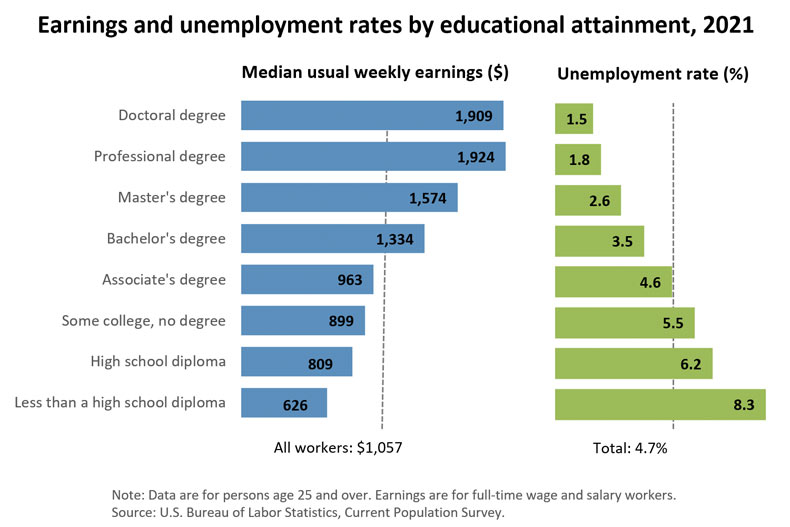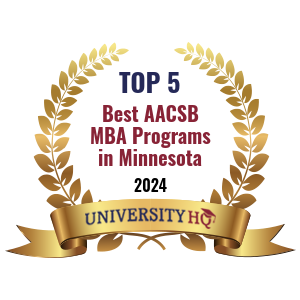University Headquarters (HQ) is an industry-leading, independent educational organization that provides independent college rankings using a proprietary formula to create first class unbiased rankings. The team at University HQ strives to provide accurate and trustworthy rankings that highlights the best programs.
Search All Programs
Overview of University of Minnesota-Duluth (UMD)
University of Minnesota at Duluth (UMD) students do more than expand their minds, however. There are more than 250 student organizations to choose from, five residence halls in which to live and fellowship, and four apartment complexes that provide a healthy transition to post-college life.
On an average day, UMD students always have something to do. Recreational activities are available every day. Some students love the 9-hole disc golf course that is free to play, with disc rental. Others may prefer to play indoors during the Minnesota winter. Options include a plethora of fitness classes, indoor climbing walls, an ice rink, gymnasiums, and more. UMD also supports a variety of outdoor trips and adventures including cross-country skiing, winter photography, snowshoeing, and fat-tire biking, among other options. On top of all this, UMD also provides intramural sports, club sports, student organizations, and even surfing on Lake Superior (bring a thick wetsuit!).
General Information
| School Type | Public |
|---|---|
| Campus Setting | City: Small |
| Campus Housing | Yes |
| Student Faculty Ratio | 16:1 |
| Graduation Rate | 65% |
| Year Founded | 1895 |

Student Enrollment
Total Students9,884
9,024
860
Undergraduate Student
Male 4,512
Female 4,512
Graduate Student
Male 430
Female 430
Explore Map
UMD Acceptance Rate and Admissions
APPLICATIONS9,610
ACCEPTANCE7,688
Acceptance Rate80%
Enrollment 2,076
| Admissions | |
|---|---|
| Application Fee | $40 |
| High School GPA | Required |
| High School Rank | Recommended |
| High School Transcripts | Required |
| College Prep Courses | Required |
| Recommendations | Recommended |
| SAT/ACT | Considered But Not Required |
| TOEFL (Test of English as a Foreign Language) | Required |
| Application Deadline | August 1 |
| Common Application Accepted | Yes |
UMD Tuition Cost & Financial Aid
The University of Minnesota–Duluth is a publicly funded institution of higher learning. Since the school is funded by taxpayer dollars, Minnesota state residents are able to attend for a reduced rate, relative to out-of-state students. Residents thus see that their gross cost of tuition, books, and other academic fees runs to only around $15,000. Their out-of-state peers pay a bit more, with their costs rising to over $20,000. When all applicable costs of living are tallied, these numbers go a bit higher. On-campus living is considered to be equal to off-campus and state residents face a gross price tag of only around $26,000. Non-residents see their gross costs hovering just above $31,000 for a whole year of living and learning.
However, the gross cost is only part of the story. Once the financial aid office applies grants and scholarships to the price, costs fall dramatically. In fact, the average net price tag for a year on the Duluth campus is only $17,000. The lowest-earning households then pay far less, with their average net price falling to around $6,000, including living costs. The highest-earning households, those reporting over $110,001 in annual income, still only pay $23,000 per year.
| Average net price | 2020-2021 |
|---|---|
| Net Price | $16,960 |
| Average Total Aid | $7,817 |
| Students Receiving Financial Aid | 87% |
| Room & Board | $8,796 |
Sticker Price
- Tuition In-State - $13,850
- Tuition Out-of-State - $19,148
- Books and Supplies - $1,200
- Room & Board - $8,796
- Other - $2,348
Academics
The University of Minnesota - Duluth is known for many things, but what stands out in any conversation is the university's academic programs. While alumni may also brag on the athletics or their Greek experiences, their academic experience is what matters. While it's important to note UMD's academic reputation, researchers seek to support that reputation with data. To that end, researchers aggregate figures that measure the retention rate, graduation rate, and other academic metrics.
The retention rate is a very important academic statistic that tells researchers how many first-time, full-time students return to UMD's campus for a second year. High retention indicates that students and their families are pleased with the school's curriculum, faculty, and campus resources. Since UMD reports a retention rate of 77%, it's clear that students are excited to continue attending UMD. That is further supported by the graduation rate, which is 65%, with 26% reported as transferring out. While transfers might be interpreted as a negative, researchers understand that transfer students tend to be highly motivated and often transfer to finish a more specific sort of degree from a more competitive institution. Thus, UMD can be said to provide an academic foundation that leads to graduation for up to 91% of its students.
Retention
Rate
4 year
Graduation
Rate
6 year
Graduation
Rate
Student Population Total
Student Population 9,884
9,024
860
Most Popular Programs & Majors
(# of Diplomas Awarded by Subject)
| All Business Majors | 379 Total Graduates / 18% |
|---|---|
| Marketing/Marketing Management, General | 113 Graduates |
| Finance, General | 95 Graduates |
| Accounting | 50 Graduates |
| Business Administration and Management, General | 50 Graduates |
| Selling Skills and Sales Operations | 20 Graduates |
| All Engineering Majors | 287 Total Graduates / 14% |
| Mechanical Engineering | 113 Graduates |
| Civil Engineering, General | 65 Graduates |
| Chemical Engineering | 51 Graduates |
| Electrical and Electronics Engineering | 43 Graduates |
| Industrial Engineering | 14 Graduates |
| All Biological and Biomedical Majors | 236 Total Graduates / 11% |
| Biology/Biological Sciences, General | 168 Graduates |
| Biochemistry | 65 Graduates |
| Biomedical Sciences, General | 3 Graduates |
| All Psychology Majors | 159 Total Graduates / 8% |
| Psychology, General | 159 Graduates |
| All Education Majors | 135 Total Graduates / 6% |
| Education, Other | 70 Graduates |
| Kindergarten/Preschool Education and Teaching | 15 Graduates |
| Social Studies Teacher Education | 14 Graduates |
| Mathematics Teacher Education | 11 Graduates |
| Music Teacher Education | 9 Graduates |
| All Other Diplomas | 43% |
Outcome & Salary
Students at the University of Minnesota at Duluth work hard for every grade but they are also eager to know how well their studies will pay off after graduation. Though there are never any guarantees for long-term earnings, researchers do take a look at how well UMD graduates fare after graduation.
The top earning UMD graduates all hail from STEM degree programs, and the mechanical engineering students top the list. Their median reported salary is $73,000. Meanwhile, the fifth highest-earning degree program seems to be the statistics students who report a median income of $66,000. Chemical engineering degree students from UMD come in on the median, with their median salary exceeding $70,000. Note that salary figures don't include other forms of compensation such as bonuses and benefits.
| Graduates Salary | |
|---|---|
| College Grads Early Career Salary | $57,500 |
| College Grads Average Salary | $69,000 |
| College Grads Mid Career Salary | $102,700 |
| Return on Investment (ROI) | |
|---|---|
| 10 Year Salary Earnings Potential | $690,000 |
| 20 Year Salary Earnings Potential | $1,717,000 |
| Cost of Education (Net Price) 4 Year | $67,840 |
| 10 Year Projected ROI | $622,160 |
| 20 Year Projected ROI | $1,649,160 |
| No College Education Salary Comparison | |
|---|---|
| National Average Salary | $38,792 |
| 10 Year Projected Income | $387,920 |
| 20 Year Projected Income | $775,840 |

Photos & Videos
Search All Programs
Overview of University of Minnesota-Duluth (UMD)
University of Minnesota at Duluth (UMD) students do more than expand their minds, however. There are more than 250 student organizations to choose from, five residence halls in which to live and fellowship, and four apartment complexes that provide a healthy transition to post-college life.
On an average day, UMD students always have something to do. Recreational activities are available every day. Some students love the 9-hole disc golf course that is free to play, with disc rental. Others may prefer to play indoors during the Minnesota winter. Options include a plethora of fitness classes, indoor climbing walls, an ice rink, gymnasiums, and more. UMD also supports a variety of outdoor trips and adventures including cross-country skiing, winter photography, snowshoeing, and fat-tire biking, among other options. On top of all this, UMD also provides intramural sports, club sports, student organizations, and even surfing on Lake Superior (bring a thick wetsuit!).
General Information
| School Type | Public |
|---|---|
| Campus Setting | City: Small |
| Campus Housing | Yes |
| Student Faculty Ratio | 16:1 |
| Graduation Rate | 65% |
| Year Founded | 1895 |

Student Enrollment
Total Students9,884
9,024
860
Undergraduate Student
Male 4,512
Female 4,512
Graduate Student
Male 430
Female 430
Explore Map
Top Rankings For University of Minnesota-Duluth
UMD Acceptance Rate and Admissions
APPLICATIONS9,610
ACCEPTANCE7,688
Acceptance Rate80%
Enrollment 2,076
| Admissions | |
|---|---|
| Application Fee | $40 |
| High School GPA | Required |
| High School Rank | Recommended |
| High School Transcripts | Required |
| College Prep Courses | Required |
| Recommendations | Recommended |
| SAT/ACT | Considered But Not Required |
| TOEFL (Test of English as a Foreign Language) | Required |
| Application Deadline | August 1 |
| Common Application Accepted | Yes |
UMD Tuition Cost & Financial Aid
The University of Minnesota–Duluth is a publicly funded institution of higher learning. Since the school is funded by taxpayer dollars, Minnesota state residents are able to attend for a reduced rate, relative to out-of-state students. Residents thus see that their gross cost of tuition, books, and other academic fees runs to only around $15,000. Their out-of-state peers pay a bit more, with their costs rising to over $20,000. When all applicable costs of living are tallied, these numbers go a bit higher. On-campus living is considered to be equal to off-campus and state residents face a gross price tag of only around $26,000. Non-residents see their gross costs hovering just above $31,000 for a whole year of living and learning.
However, the gross cost is only part of the story. Once the financial aid office applies grants and scholarships to the price, costs fall dramatically. In fact, the average net price tag for a year on the Duluth campus is only $17,000. The lowest-earning households then pay far less, with their average net price falling to around $6,000, including living costs. The highest-earning households, those reporting over $110,001 in annual income, still only pay $23,000 per year.
| Average net price | 2020-2021 |
|---|---|
| Net Price | $16,960 |
| Average Total Aid | $7,817 |
| Students Receiving Financial Aid | 87% |
| Room & Board | $8,796 |
Sticker Price
- Tuition In-State - $13,850
- Tuition Out-of-State - $19,148
- Books and Supplies - $1,200
- Room & Board - $8,796
- Other - $2,348
Academics
The University of Minnesota - Duluth is known for many things, but what stands out in any conversation is the university's academic programs. While alumni may also brag on the athletics or their Greek experiences, their academic experience is what matters. While it's important to note UMD's academic reputation, researchers seek to support that reputation with data. To that end, researchers aggregate figures that measure the retention rate, graduation rate, and other academic metrics.
The retention rate is a very important academic statistic that tells researchers how many first-time, full-time students return to UMD's campus for a second year. High retention indicates that students and their families are pleased with the school's curriculum, faculty, and campus resources. Since UMD reports a retention rate of 77%, it's clear that students are excited to continue attending UMD. That is further supported by the graduation rate, which is 65%, with 26% reported as transferring out. While transfers might be interpreted as a negative, researchers understand that transfer students tend to be highly motivated and often transfer to finish a more specific sort of degree from a more competitive institution. Thus, UMD can be said to provide an academic foundation that leads to graduation for up to 91% of its students.
Retention
Rate
4 year
Graduation
Rate
6 year
Graduation
Rate
Student Population Total
Student Population 9,884
9,024
860
Most Popular Programs & Majors
(# of Diplomas Awarded by Subject)
| All Business Majors | 379 Total Graduates / 18% |
|---|---|
| Marketing/Marketing Management, General | 113 Graduates |
| Finance, General | 95 Graduates |
| Accounting | 50 Graduates |
| Business Administration and Management, General | 50 Graduates |
| Selling Skills and Sales Operations | 20 Graduates |
| All Engineering Majors | 287 Total Graduates / 14% |
| Mechanical Engineering | 113 Graduates |
| Civil Engineering, General | 65 Graduates |
| Chemical Engineering | 51 Graduates |
| Electrical and Electronics Engineering | 43 Graduates |
| Industrial Engineering | 14 Graduates |
| All Biological and Biomedical Majors | 236 Total Graduates / 11% |
| Biology/Biological Sciences, General | 168 Graduates |
| Biochemistry | 65 Graduates |
| Biomedical Sciences, General | 3 Graduates |
| All Psychology Majors | 159 Total Graduates / 8% |
| Psychology, General | 159 Graduates |
| All Education Majors | 135 Total Graduates / 6% |
| Education, Other | 70 Graduates |
| Kindergarten/Preschool Education and Teaching | 15 Graduates |
| Social Studies Teacher Education | 14 Graduates |
| Mathematics Teacher Education | 11 Graduates |
| Music Teacher Education | 9 Graduates |
| All Other Diplomas | 43% |
Outcome & Salary
Students at the University of Minnesota at Duluth work hard for every grade but they are also eager to know how well their studies will pay off after graduation. Though there are never any guarantees for long-term earnings, researchers do take a look at how well UMD graduates fare after graduation.
The top earning UMD graduates all hail from STEM degree programs, and the mechanical engineering students top the list. Their median reported salary is $73,000. Meanwhile, the fifth highest-earning degree program seems to be the statistics students who report a median income of $66,000. Chemical engineering degree students from UMD come in on the median, with their median salary exceeding $70,000. Note that salary figures don't include other forms of compensation such as bonuses and benefits.
| Graduates Salary | |
|---|---|
| College Grads Early Career Salary | $57,500 |
| College Grads Average Salary | $69,000 |
| College Grads Mid Career Salary | $102,700 |
| Return on Investment (ROI) | |
|---|---|
| 10 Year Salary Earnings Potential | $690,000 |
| 20 Year Salary Earnings Potential | $1,717,000 |
| Cost of Education (Net Price) 4 Year | $67,840 |
| 10 Year Projected ROI | $622,160 |
| 20 Year Projected ROI | $1,649,160 |
| No College Education Salary Comparison | |
|---|---|
| National Average Salary | $38,792 |
| 10 Year Projected Income | $387,920 |
| 20 Year Projected Income | $775,840 |

Photos & Videos
Related Top College Resources







